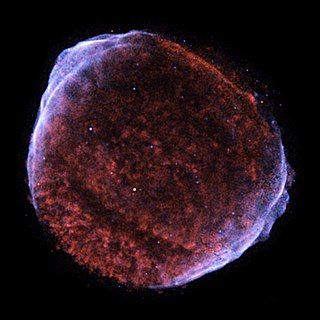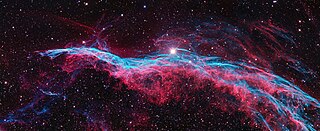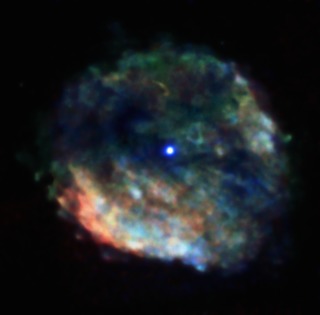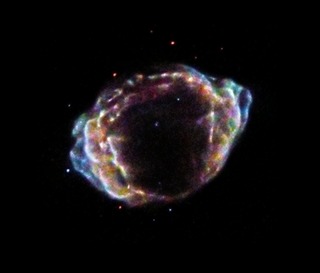
A nebula is a distinct luminescent part of interstellar medium, which can consist of ionized, neutral, or molecular hydrogen and also cosmic dust. Nebulae are often star-forming regions, such as in the "Pillars of Creation" in the Eagle Nebula. In these regions, the formations of gas, dust, and other materials "clump" together to form denser regions, which attract further matter and eventually become dense enough to form stars. The remaining material is then thought to form planets and other planetary system objects.

The Large Magellanic Cloud (LMC) is a spiral satellite galaxy of the Milky Way. At a distance of around 50 kiloparsecs (163,000 light-years), the LMC is the second- or third-closest galaxy to the Milky Way, after the Sagittarius Dwarf Spheroidal (c. 16 kiloparsecs (52,000 light-years) away) and the possible dwarf irregular galaxy called the Canis Major Overdensity. Based on the D25 isophote at the B-band (445 nm wavelength of light), the Large Magellanic Cloud is about 9.86 kiloparsecs (32,200 light-years) across. It is roughly one-hundredth the mass of the Milky Way and is the fourth-largest galaxy in the Local Group, after the Andromeda Galaxy (M31), the Milky Way, and the Triangulum Galaxy (M33).

SN 1604, also known as Kepler's Supernova, Kepler's Nova or Kepler's Star, was a Type Ia supernova that occurred in the Milky Way, in the constellation Ophiuchus. Appearing in 1604, it is the most recent supernova in the Milky Way galaxy to have been unquestionably observed by the naked eye, occurring no farther than 6 kiloparsecs from Earth. Before the adoption of the current naming system for supernovae, it was named for Johannes Kepler, the German Astronomer who described it in De Stella Nova.

A supernova remnant (SNR) is the structure resulting from the explosion of a star in a supernova. The supernova remnant is bounded by an expanding shock wave, and consists of ejected material expanding from the explosion, and the interstellar material it sweeps up and shocks along the way.

Westerhout 50 (W50) or SNR G039.7-02.0, also referred to as the Manatee Nebula, is a supernova remnant located in the constellation Aquila, about 18,000 light years away. In its centre lies the micro-quasar SS 433, whose jets are distorting the remnant's shell. Most likely W50 and SS 433 are related objects, remnants from a supernova which occurred about 20,000 years ago.

SN 1006 was a supernova that is likely the brightest observed stellar event in recorded history, reaching an estimated −7.5 visual magnitude, and exceeding roughly sixteen times the brightness of Venus. Appearing between April 30 and May 1, 1006, in the constellation of Lupus, this "guest star" was described by observers across China, Japan, modern-day Iraq, Egypt, and Europe, and was possibly recorded in North American petroglyphs. Some reports state it was clearly visible in the daytime. Modern astronomers now consider its distance from Earth to be about 7,200 light-years or 2,200 parsecs.

Cassiopeia A (Cas A) is a supernova remnant (SNR) in the constellation Cassiopeia and the brightest extrasolar radio source in the sky at frequencies above 1 GHz. The supernova occurred approximately 11,000 light-years (3.4 kpc) away within the Milky Way; given the width of the Orion Arm, it lies in the next-nearest arm outwards, the Perseus Arm, about 30 degrees from the Galactic anticenter. The expanding cloud of material left over from the supernova now appears approximately 10 light-years (3 pc) across from Earth's perspective. It has been seen in wavelengths of visible light with amateur telescopes down to 234 mm (9.25 in) with filters.

SN 1572, or B Cassiopeiae, was a supernova of Type Ia in the constellation Cassiopeia, one of eight supernovae visible to the naked eye in historical records. It appeared in early November 1572 and was independently discovered by many individuals.

W49B is a nebula in Westerhout 49 (W49). The nebula is a supernova remnant, probably from a type Ib or Ic supernova that occurred around 1,000 years ago. It may have produced a gamma-ray burst and is thought to have left a black hole remnant.

The Cygnus Loop is a large supernova remnant (SNR) in the constellation Cygnus, an emission nebula measuring nearly 3° across. Some arcs of the loop, known collectively as the Veil Nebula or Cirrus Nebula, emit in the visible electromagnetic range. Radio, infrared, and X-ray images reveal the complete loop.

The Vela supernova remnant is a supernova remnant in the southern constellation Vela. Its source Type II supernova exploded approximately 11,000 years ago. The association of the Vela supernova remnant with the Vela pulsar, made by astronomers at the University of Sydney in 1968, was direct observational evidence that supernovae form neutron stars.

The Veil Nebula is a cloud of heated and ionized gas and dust in the constellation Cygnus.

IC 443 is a galactic supernova remnant (SNR) in the constellation Gemini. On the plane of the sky, it is located near the star Eta Geminorum. Its distance is roughly 5,000 light years from Earth.

1E 161348-5055.1, commonly shortened to 1E 161348-5055, is a neutron star found in the centre of RCW103 supernova remnant. It is a periodic X-ray source with a period of 6.67 hours. It is approximately 2000 years old. It is 10,000 light years away in the constellation Norma. Although once considered a central compact object, the observed bursts have caused it to be reclassified as either a magnetar or possibly an x-ray binary.

SN 185 was a transient astronomical event observed in the year AD 185, likely a supernova. The transient occurred in the direction of Alpha Centauri, between the constellations Circinus and Centaurus, centered at RA 14h 43m Dec −62° 30′, in Circinus. This "guest star" was observed by Chinese astronomers in the Book of Later Han (后汉书), and might have been recorded in Roman literature. It remained visible in the night sky for eight months. This is believed to be the first supernova for which records exist.

The known history of supernova observation goes back to 1006 AD. All earlier proposals for supernova observations are speculations with many alternatives.

G1.9+0.3 is a supernova remnant (SNR) in the constellation of Sagittarius. It is the youngest-known SNR in the Milky Way, resulting from an explosion the light from which would have reached Earth some time between 1890 and 1908. The explosion was not seen from Earth as it was obscured by the dense gas and dust of the Galactic Center, where it occurred. The remnant's young age was established by combining data from NASA's Chandra X-ray Observatory and the VLA radio observatory. It was a type Ia supernova. The remnant has a radius of over 1.3 light-years.

G350.1-0.3 is a supernova remnant which is located in the constellation Scorpius. It is in the Milky Way, and possibly associated with a neutron star formed in the same supernova explosion. The object was formerly mistakenly classified as a distant galaxy.

NCG 5204 is a Magellanic spiral galaxy located about 14.5 million light-years away from Earth in the constellation of Ursa Major and is a member of the M101 Group of galaxies. It has a galaxy morphological classification of SA(s)m and is highly irregular, with only the barest indication of any spiral arm structure. The galaxy's most prominent feature is an extremely powerful X-ray source designated NGC 5204 X-1. This has resulted in the galaxy being the target of several studies due to the strength of the source and its relative proximity to Earth.
A central compact object (CCO) is an x-ray source found near the center of a young, nearby supernova remnant (SNR). Given the observed x-ray flux and spectra observed from these objects, the almost certain conclusion is that CCOs are the remnant neutron stars which resulted from the recent supernova. Unlike most pulsars, CCOs generally lack pulsed radio emission or variation in the observed x-rays due to such phenomena being either nonexistent or difficult to detect. The weaker magnetic fields than most other detected neutron stars means that most of the detected x-rays are due to blackbody radiation. Confirmation that the CCO is associated with the past supernova can be done using the kinematics of the objects and matching them to the age and kinematics of the host SNR.


















